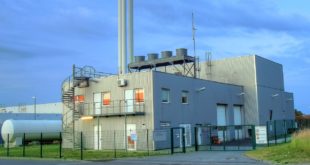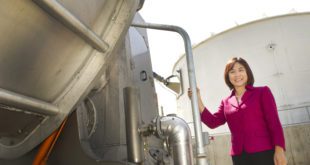What if we could take all that carbon dioxide that we have too much of and turn it into a clean energy source? Sound far-fetched? Well, it isn’t really. After all, plants do it every day. That is much of the rationale behind biofuels. Let the plants store the solar energy as sugars, starches, etc., which we then convert into things that our machinery can use (e.g. ethanol, bio-diesel).
But handling all that biomass is heavy, unwieldy and messy. What if we could skip all that and just create a fuel from CO2, using sunlight to power the process, but without relying on biological processes?
That is the idea behind Liquid Light, a company that “develops electrocatalytic technology to make major chemicals from low-cost, globally abundant carbon dioxide (CO2). The company has over 100 patents for producing chemicals including ethylene glycol, propylene, isopropanol, methyl-methacrylate and acetic acid using carbon dioxide as a feedstock in a low-energy conversion process. The process takes in CO2, combines it with another medium which could be water, natural gas or smokestack effluents, and, using any type of energy source, produces these various chemicals.
Recently, a research team at Princeton, used Liquid Light catalysts to produce formates.Formates are chemicals that are used as energy sources by certain microbial organisms. The team used standard solar panels to drive the process. This is an important step in developing a type of artificial photosynthesis. This is not the first group to produce something like this. But the efficiency seen here is 9x better than previous results and fully twice the efficiency of natural photosynthesis.
Other approaches have focused on hydrogen production. At the University of Rochester for example, Rich Eisenberg and Todd Krauss have made several key advances in developing a form of artificial photosynthesis that could also potentially meet the hydrogen production challenge. According to Eisenberg, “The goal is just to take water, sunlight, and some black box that will convert that into oxygen and hydrogen which could then be fed into a fuel cell so that you could then get useful electrical work out. We’ve focused our efforts on the half-reaction that produces hydrogen from water. In order to do this you need three components: a light absorber, a catalyst and a source of electrons that will take protons from water and make it into H2. This has been standard practice for some time, but generally, the light absorber and the catalyst, in the past have contained precious metals. So, one focus of our research has been to find materials that are more abundant and less expensive.”
The pair used nano-particles, also known as quantum dots, in order to create a low-cost light absorber that works well with a durable water-soluble nickel catalyst. Nickel is quite abundant and far lower in cost than any of the precious metals used previously. With this “homogeneous catalysis” process, they have achieved over a million turnovers, which is the number of reactions taking place before any components need replenishment. At the same time they have seen quantum yields in excess of 35 percent, which is seven times higher than natural photosynthesis. These are significant milestones; though more work needs to be done in developing the oxygen half-reaction that will provide the electrons required to make this a closed-loop process. In the mean time, they need to add ascorbic acid to the solution to provide this function. Even so, they have attracted some interest from a major energy company.
New pathways to a clean energy economy continue to appear, even as those already in existence flourish and thrive. An approach like Liquid Light’s, which pulls carbon dioxide out of the air, could be considered carbon negative. This is the kind of innovation that can potentially make a big difference.
Article by RP Siegel of Justmeans, appearing courtesy 3BL Media.
 Alternative Energy HQ solar power for homes, wind energy, and bio fuel issues
Alternative Energy HQ solar power for homes, wind energy, and bio fuel issues








This absolutely must be made reality if we are to be able to control our climate. Carbon capture and use, in addition to an eventually full transition to renewable energy sources is the energy recipe that we need.